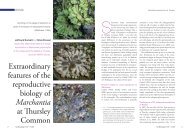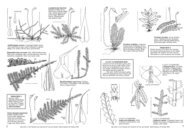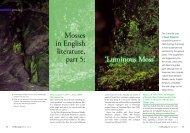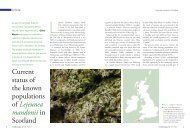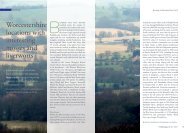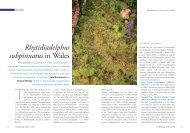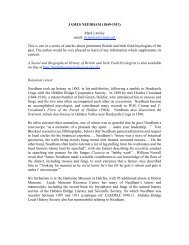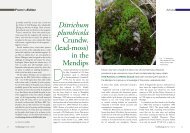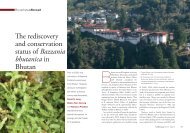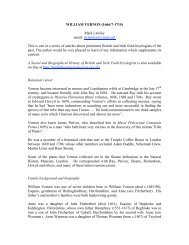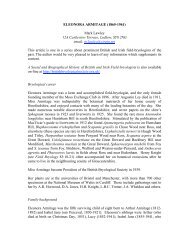London's changing bryophyte flora
London's changing bryophyte flora
London's changing bryophyte flora
Create successful ePaper yourself
Turn your PDF publications into a flip-book with our unique Google optimized e-Paper software.
(a) (b) (a) (b) (c)<br />
(c)<br />
n Fig. 1. Saxicolous species. (a) The Bird Bridge, Hampstead Heath.<br />
Crevices in the brickwork harbour Gymnostomum viridulum, whist ivy<br />
in the dell below supports epiphyllic Metzgeria violacea. (b) Entrance<br />
to the Egyptian Avenue, Highgate Cemetery West with Zygodon<br />
rupestris growing on the columns, shown in (c). J.G. Duckett<br />
Gardiner reckoned that the western half of the<br />
county had been fairly well-worked, but that<br />
there was still quite a lot to do in the eastern half,<br />
including Hampstead Heath, and that it would<br />
take another year to complete the county <strong>flora</strong>.<br />
Sadly, his failing health left his dreams unfulfilled<br />
and it was left to succeeding bryologists to<br />
continue the London story. Since Jack’s death in<br />
1989, Elinor Wiltshire has retrod the same paths<br />
as Benbow in the north west, whilst Christine<br />
Rieser and Ken Adams found Hampstead Heath<br />
to be a veritable treasure trove of <strong>bryophyte</strong> biodiversity<br />
(Rieser, 1998).<br />
Saxicolous species<br />
Apart from a rapidly increasing frequency of<br />
Orthotrichum anomalum, Didymodon vinealis,<br />
and Syntrichia intermedia since 2000 [all three<br />
are recorded as rare or local by Kent (2000)],<br />
on gravestones, old walls and masonry in fairly<br />
exposed situations, the most notable additions<br />
to these habitats (typically colonized in London<br />
by Amblystegium serpens, Brachytheciastrum<br />
velutinum, Bryum capillare, B. radiculosum,<br />
Grimmia pulvinata, Hypnum cupressiforme, Rhynchostegium<br />
confertum, Schistidium crassipilum and<br />
Tortula muralis) are O. cupulatum, O. rupestre and<br />
Zygodon viridissimus, and surprisingly the more<br />
typically epiphytic species Z. rupestris (Fig. 1b,<br />
c). The recent records for Homalia trichomanoides<br />
and Anomodon viticulosus are both from an old<br />
concrete wall (Table 1). Porella platyphylla, last<br />
seen in 1961 but without voucher, is also likely<br />
to be found in this habitat, but Pseudocrossidium<br />
revolutum is remarkably uncommon in London.<br />
Given the recent records of Leucodon sciuroides<br />
on walls and tombstones in nearby south-west<br />
Surrey, where it was last seen in 1895, this species<br />
must now be considered as a likely recolonist in<br />
London in the near future. Racomitrium aciculare,<br />
introduced on gritstone boulders used for<br />
landscaping in about 2000, continues to thrive<br />
and produce sporophytes in Mile End Park.<br />
Damp, shaded stonework, including that along<br />
canal banks, was a habitat well-scrutinized by<br />
bryologists at the end of the 20th century. Since<br />
Fred Ambrose found Didymodon umbrosus along<br />
the Grand Union canal at Cowley Lock in 1977,<br />
Jack Gardiner, Monica Milne-Smith and Ken<br />
(f) (g)<br />
n Fig. 2. Light micrographs of Gymnostomum viridulum<br />
(a–e) and Fissidens fontanus (f, g). (a–e) Gemmiferous<br />
protonemata of G. viridulum from Highgate Cemetery<br />
West. (a) Swollen apical cell of an upright chloronemal<br />
filament that will subsequently develop into a gemma.<br />
Abscission cell is arrowed. (b) Gemma with its<br />
abscission cell (arrowed) on the point of rupture. (c)<br />
Scar remaining (arrowed) after gemma liberation. Also<br />
note the elongate abscission cell in the filament on the<br />
right. (d, e) Mature gemmae with pigmented walls and<br />
acuminate apices. (e, f) Fissidens fontanus, Regent’s<br />
Canal, Mile End with the apices of the main rhizoid<br />
axes infected with rostellopsid fungi. Bars, (a–e, g)<br />
50 μm; (f) 100 μm. Silvia Pressel<br />
Adams discovered this species in several other<br />
localities all over London. In contrast, the only<br />
record for Leptobarbula berica in v.-c. 21 remains<br />
that by Jack Gardiner and Monica Milne-Smith<br />
from Hampton Court in 1977, and Gyroweisia<br />
tenuis has only been refound near an old locality<br />
as recently as 2007 (Table 2). Against this<br />
background, it came as a complete surprise when<br />
microscopic examination of similar-looking<br />
plants on damp, shaded stonework and masonry<br />
from Highgate Cemetery West (Fig. 1a) revealed<br />
these to be Gymnostomum viridulum, immediately<br />
recognizable from its highly characteristic protonemal<br />
gemmae (Fig. 2a–e). In contrast to the<br />
gemmae in the vast majority of the Pottiales<br />
examined to date that lack abscission cells<br />
(Duckett et al., 2004), these are a constant<br />
feature of G. viridulum.<br />
The discovery of G. viridulum far outside its<br />
previous British range (Hill et al., 1992) poses<br />
two questions; was it overlooked or is it a recent<br />
arrival, perhaps associated with climate change?<br />
The latter now seems the more likely. Subsequent<br />
to its discovery in Highgate Cemetery West, it has<br />
now been found in several likely ‘Gyroweisia-ish’<br />
spots on Hampstead Heath (Fig. 1a), including<br />
a population with abundant sporophytes in the<br />
Hill Garden. In 2008, it also turned up in the<br />
ornamental garden in Regent’s Park. It is very<br />
unlikely that Elinor Wiltshire overlooked it<br />
when she recorded Didymodon tophacea from the<br />
same place in 1997.<br />
Hard standings and old tarmac in London<br />
have also witnessed major recent changes in their<br />
<strong>bryophyte</strong> <strong>flora</strong>s. These now support what might<br />
best be described as a veritable ‘syntrichietum’<br />
with vigorous swards of Syntrichia montana, S.<br />
ruralis var. ruralis and intermediates with var.<br />
ruraliformis. Also frequent are S. latifolia and<br />
Didymodon nicholsonii, both previously recorded<br />
almost exclusively from riverine habitats. Ken<br />
34 FieldBryology No98 | Jun09 FieldBryology No98 | Jun09 35<br />
(d)<br />
(e)



